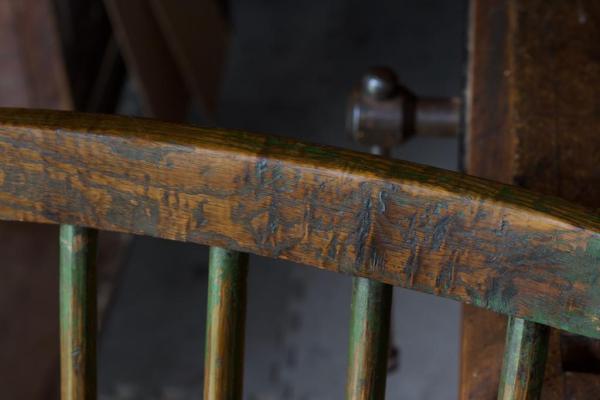
The stick chairs that I make are on the contemporary side, with lots of chamfers, sharp angles and crisp facets. But the chairs I love – the ones that take my breath away – are the old ones, especially from Wales. These chairs are worn and polished from hundreds of hands and thousands of nights in front of the fire.
The materials the chairs are made from are nothing exotic – they are built from the hedges and woods surrounding the maker.
All of these things add up to a chair that I don’t have the materials or skills (especially finishing skills) to make.
But John Porritt does. You might remember John from a 2019 blog entry when I visited him in New York. Since then, we’ve tried to arrange for him to teach a class here, which was unfortunately cancelled by the pandemic.

Recently John finished up his latest batch of chairs and had a professional photographer, Lydia Curran of Monster Machine in Chatham, NY, take some photos. I have been staring at these photos for more than a week now. The chairs are gorgeous, like nothing I have seen from any modern maker.
John is one of those rare makers who understands how these chairs should look and feel. The forms are spot-on – like something that is 200 years old. The surfaces and finishes are truly extraordinary. Though John isn’t trying to make fakes, these chairs look like the chairs I’ve seen at St Fagans National Museum of History and Tim Bowen Antiques in Ferryside, Wales.

John has invited me and Megan to his workshop to learn more about his finishing techniques. And I am eager to take him up on his offer. “One of my finishing techniques,” John writes, “maybe the most important – is belligerence.”
These chairs are extremely special. And though this might sound weird coming from a guy who sells chairs: If you are at all interested in the real deal, talk to John about buying one of his chairs. In addition to his deep knowledge of chairs from the British Isles and finishing, John restores old tools for several prominent tool dealers. He’s a delight to talk to and one of the hidden gems in the United States.
To contact John, email is best: porritt3@gmail.com.
— Christopher Schwarz











Amazing,just amazing.
I freakin love these!! Great looking chairs.
The arm bow looks like a lap joint that’s pinned. I wish I had this level of skill, but did early chair makers ever use locked scarf joints, or they just weren’t needed or didn’t have time to faff about with it. Stole faff from another wood worker blogger.
Nothing wrong with “faff” good old english word for unnecessary messing about. As in what are you “faffing about at”
These are stunning. Especially the finishes. If you ever go visit and learn, try to convince Porritt to write somewhere about finishing. Or see if he’d consent to a footage shoot interviewing him, in his shop.
Wow.
I see why you are enamored with these chairs. These are the very best and represent the highest standard for an amateur like myself. Thanks for sharing.
Brings to mind the following. Many forms and attributions.
A poem is never finished, only abandoned. A work is never completed, but merely abandoned. A work of art is never completed, only abandoned. Books are never finished—they are merely abandoned.
Paul Valery, usually. I delight in finding surfaces left rough, elements without finish, when examining old pieces. Let this be a lesson to us all.
Elia Bizzarri and Curtis Buchanan did a recent video on YouTube about “Beauty vs The Sterility of Perfection”. It’s short, but covers well why we are drawn to handmade items that aren’t perfect cookie cutter duplicates.
If you did not tell me otherwise, I would believe these were from a museum and a very reckless curator said “sure, take ’em outside…”
Lovely to see your wonderful chairs – many congratulations on some fine work. I still treasure my ‘Shaker’ table. Must be 30 years old by now! Barbara